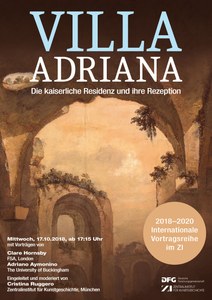Vortragsreihe // Villa Adriana: Die kaiserliche Residenz und ihre Rezeption / Teil 2
Termindetails
Wann
von 17:15 bis 19:30
Art
Wo
Diese zwei unter diesem Titel gefassten Vorträge sind Teil einer bis 2020 ausgelegten, semesterübergreifenden Vortragsreihe im Kontext des DFG-Projekts "Mikrokosmos Villa Adriana. Ein künstlerischer Interaktionsraum im Europa des 18. und 19. Jahrhunderts."
PROGRAMM >>
17. Oktober 2018
17:15h Cristina Ruggero, ZI, München: Bares für Rares: Antike aus der Hadriansvilla und der römische Kunstmarkt
17:45h Clare Hornsby, FSA, London: Man of Spirit, Man of Taste, Man of Fashion: deciphering identities of the British collectors of ancient marbles.
[more information see below]
18:30h Adriano Aymonino, The University of Buckingham, Buckingham: The reception of ancient painting in the eighteenth century: theoretical debate, antiquarian publications and the visual arts
[more information see below]

Clare Hornsby // Man of Spirit, Man of Taste, Man of Fashion: deciphering identities of the British collectors of ancient marbles
“No nation under heaven so nearly resembles the ancient Greeks and Roman as we.” (Jonathan Richardson the Elder, Essay on the Theory of Painting 1715). This remark is part of the background to the British ambition for excellence in the understanding and appreciation of the antique and should be considered when attempting any examination of the phenomenon of collecting antiquities, an activity that has been called “the British conquest of the marbles”. The claim to an inheritance from the ancient world forms part of the national theory of taste that was argued and articulated by critics and was employed informally in the letters exchanged between the collectors, dealers and connoisseurs active in the antiquities market of eighteenth century Rome. It is from such sources that our knowledge of this complex network derive.
This talk will examine some examples of motivations for collecting: art as investment, response to peer pressure or fashion, ambition to form taste or to improve national standards; rarely were the motivations clear cut. The collectors included here will range from the politically ambitious commoner Bubb Dodington and his highly-placed dealer Cardinal Albani in the late 1740s, to the archetype of the nobleman collector the Earl of Shelburne, who acquired several pieces from Hadrian’s Villa in the 1760s and 70s. Others considered are the obsessively acquisitive gentleman-scholar Charles Townley and the banker-collector Lyde Browne, their activities furnishing us with a look at the role of the secondary market and the expansion of the mania for collecting. For all of these collectors, Hadrian’s Villa was the provenance par excellence for any ancient statue; reference will be made in this talk to some of the sculptures discovered there and how the British excavators and dealers used that provenance to add even further value to the perennial glamour of the ancient work of art.
Clare Hornsby: is an independent art and cultural historian; she was formerly Assistant Director at the British School at Rome and later Research Fellow at the Paul Mellon Centre for Studies in British Art in London. Her work has focussed on the eighteenth-century in Italy, France and England, particularly the phenomenon of the Grand Tour and the art and antiquities market between Rome and Great Britain. In 2010 she published Digging and Dealing in Eighteenth Century Rome (with the late Ilaria Bignamini) with Yale University Press and more recently has contributed essays on this subject to the volumes The Grand Tour and its Legacy (Fairleigh Dickinson University Press 2015) and Kunstmarkt und Kunstbetrieb in Rom (1770–1840) Akteure und Handlungsorte (Bibliothek DHR Rom 2019). She is currently completing a study of the architecture and architectural drawings at West Wycombe Park, part of the digital humanities project British Country Houses Collecting and Display for the Paul Mellon Centre. She is a Fellow of the Society of Antiquaries of London.
________________________
Adriano Aymonino // The reception of ancient painting in the eighteenth century: theoretical debate, antiquarian publications and the visual arts
This talk focuses on the nature of the relationship between the reception of ancient painting and the humanistic theory of art. It argues that this relationship was twofold: on the one hand, surviving textual evidence on Greek and Roman painting provided examples, tropes and principles that were instrumental in shaping art theory, from Leon Battista Alberti to Giovanni Pietro Bellori and the theoreticians of eighteenth-century classicism. On the other hand, the almost complete lack of physical remains of these artworks contributed to an idealised vision of ancient painting that was equally influential in defining some of the essential tendencies that shaped this theoretical tradition. Specifically, my paper will investigate how the relationship between theory and object evolved in the face of those new discoveries, publications and antiquarian ideas that proliferated over the course of the eighteenth century – with a particular focus on Hadrian’s Villa.
Adriano Aymonino: is Lecturer and Director of Undergraduate Programmes in the Department of History of Art at the University of Buckingham. His main interest is the reception of the classical tradition in the Early Modern period, with a particular focus on eighteenth-century Britain. In past years he has been a research fellow at the Paul Mellon Centre, at the Getty Research Institute and at the Huntington Library. In 2013 he organised an exhibition on the Topham Collection at Eton College Library and in 2015 curated the exhibition Drawn from the Antique: Artists and the Classical Ideal, held at the Sir John Soane’s Museum in London. He is currently working on his book on the architectural language of Robert Adam, which will be published by Yale University Press, and – with Nick Penny and Eloisa Dodero – on a revised edition of Francis Haskell and Nicholas Penny’s Taste and the Antique.
